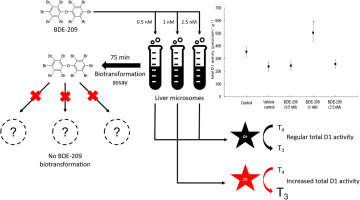Environmental Research ( IF 7.7 ) Pub Date : 2018-02-22 , DOI: 10.1016/j.envres.2018.01.001 Anthony François , Jonathan Verreault

|
Studies have shown that debromination of the major component in the deca-brominated diphenyl ether mixture (deca-BDE), BDE-209, occurs in vivo in birds. Recent work from our laboratory on breeding ring-billed gulls (Larus delawarensis) exposed to elevated PBDE concentrations in the densely-populated metropolis of Montreal (Canada) further suggests that BDE-209 debromination is potentially catalyzed by deiodinases in liver microsomes. The first objective of this study was to determine if type 1 deiodinase (D1) was involved in the in vitro debromination of BDE-209 in liver microsomes of ring-billed gulls. The second objective was to determine if there was an interaction between D1 and BDE-209 using an in vitro D1 activity assay. No depletion of BDE-209 was observed in gull liver microsomes. A significant 42% increase in total D1 activity was found in gull liver microsomes at the medium BDE-209 concentration (1.0 nM), although not at the low (0.5 nM) or high (2.5 nM) concentrations, suggesting potential non-dose related interaction with D1. Moreover, no correlation was found between total D1 activity in liver microsomes and plasma thyroid hormone levels, although there was a negative relationship between plasma BDE-209 concentrations and FT3 levels. Results from this study suggest that debromination of BDE-209 did not occur using present in vitro assay conditions, although indicated potential interaction with D1 that may have implication on circulating thyroid hormone status.
中文翻译:

富含PBDE的鸟类中十溴联苯醚和肝脏脱碘酶之间的相互作用
研究表明,十溴代二苯醚混合物(deca-BDE)BDE-209中的主要成分在体内发生脱溴。我们实验室最近对在蒙特利尔(加拿大)人口稠密的大都市中暴露于高浓度PBDE浓度的环状带嘴鸥(Larus delawarensis)的研究进一步表明,BDE-209脱溴作用可能是由肝微粒体中的脱碘酶催化的。这项研究的第一个目的是确定1型脱碘酶(D1)是否参与了环鸥肝微粒体中BDE-209的体外脱溴处理。第二个目标是使用体外方法确定D1和BDE-209之间是否存在相互作用D1活性测定。在鸥肝微粒体中未观察到BDE-209的消耗。在中度BDE-209浓度(1.0 nM)下,鸥肝微粒体的总D1活性显着增加了42%,尽管在低浓度(0.5 nM)或高浓度(2.5 nM)并非如此,表明潜在的非剂量相关性与D1的互动。此外,尽管血浆BDE-209浓度与FT 3水平呈负相关,但在肝微粒体中总D1活性与血浆甲状腺激素水平之间没有相关性。这项研究的结果表明,尽管显示了与D1的潜在相互作用,可能与循环甲状腺激素状态有关,但在目前的体外测定条件下并未发生BDE-209的脱溴。

































 京公网安备 11010802027423号
京公网安备 11010802027423号